Hylotelephium ‘Autumn Joy’
‘Autumn Joy’ or ‘Herbstfreude’ sedum is a reliable and attractive perennial known for its ability to emerge in spring as if winter never happened, unscathed and still beloved by all.
Its fleshy, green foliage fills in quickly and behaves well, rarely crowding out its perennial pals.
Small broccoli-like florets emerge, developing toward fall when they pop open, revealing small blooms in lovely shades of pink. Even as the flowers fade, their beauty continues.
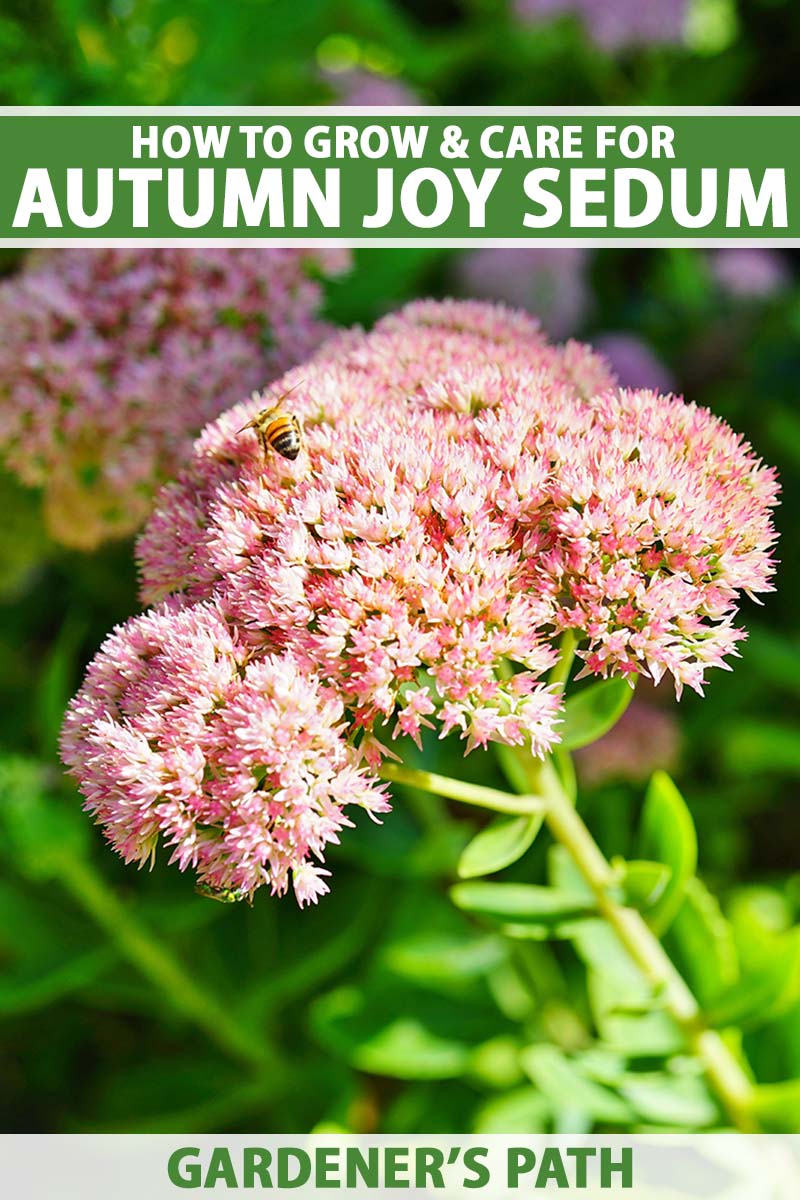
We link to vendors to help you find relevant products. If you buy from one of our links, we may earn a commission.
Living up to its name, this low-maintenance plant is pure joy, not only in autumn but throughout the growing season!
The truth is, this sedum cultivar is so popular, it may already be growing in your garden right now.
And if it isn’t, it should be. It works wonders in rock gardens, borders, or even as a focal point – no matter your landscape design, you’ll love the versatility of ‘Autumn Joy.’
In this guide, I’ll discuss everything you need to know to grow your own ‘Autumn Joy.’ Here’s what I’ll be covering:
What You’ll Learn
What Is ‘Autumn Joy’ Sedum?
‘Autumn Joy’ stands out from many perennials in the garden.
Toward summer’s end, while most flowers are spent and moving toward the end of their blooming phases, this plant is just gearing up for its moment in the spotlight.

This hardy herbaceous perennial enchants, not only in the fall, but all year long as it moves through its growth cycle.
It begins in early spring when small green clusters of leaves emerge from the soil, resembling an adorable miniature cabbage patch.
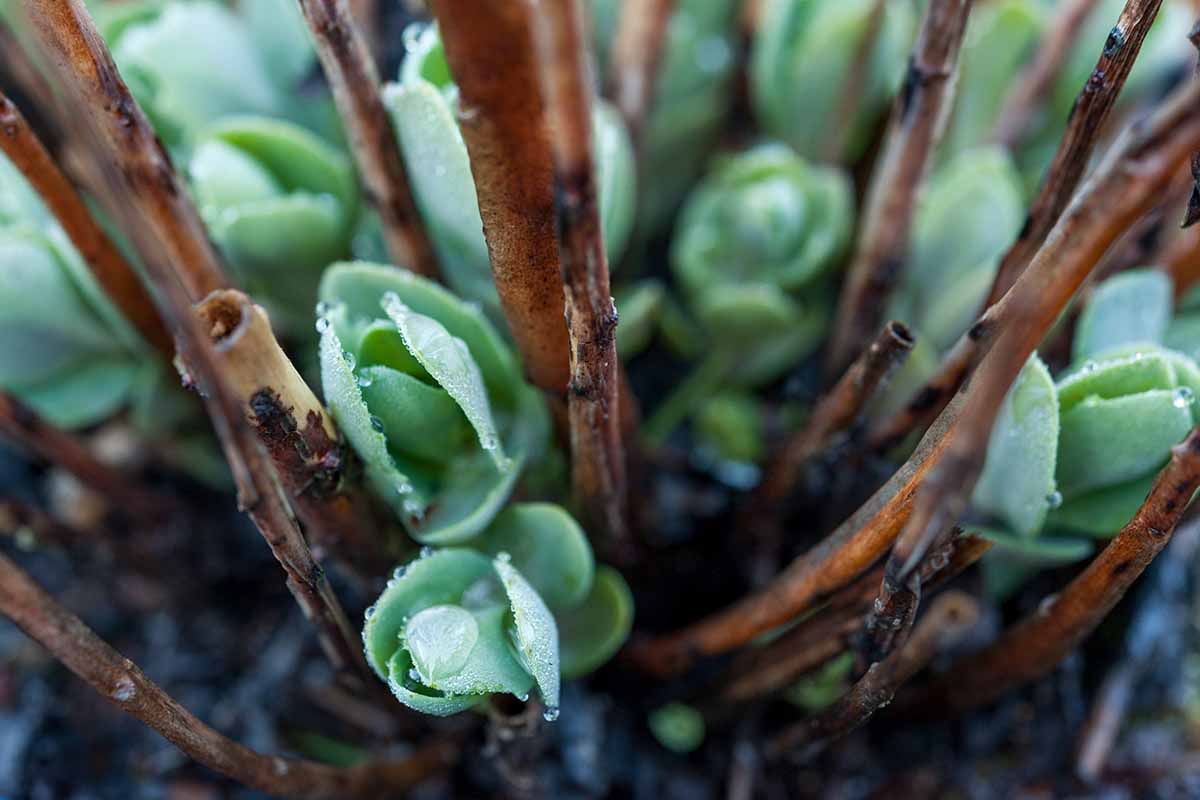
‘Autumn Joy’ grows upright to a height of one to two feet tall, and fills in up to two feet wide, with a compact, rounded shape.
Mature leaves are fleshy, gray-green or blue-green in color, with toothy, serrated edges.
The stems are thick and hefty, bulking the body of the plant. This makes an eye-catching contrast to other plants in the landscape.

Flower heads form at the ends of the stems, resembling small, pale green heads of broccoli.
Moving into September and October, the buds gradually change color from green to a light pink, dusty rose, or coral.
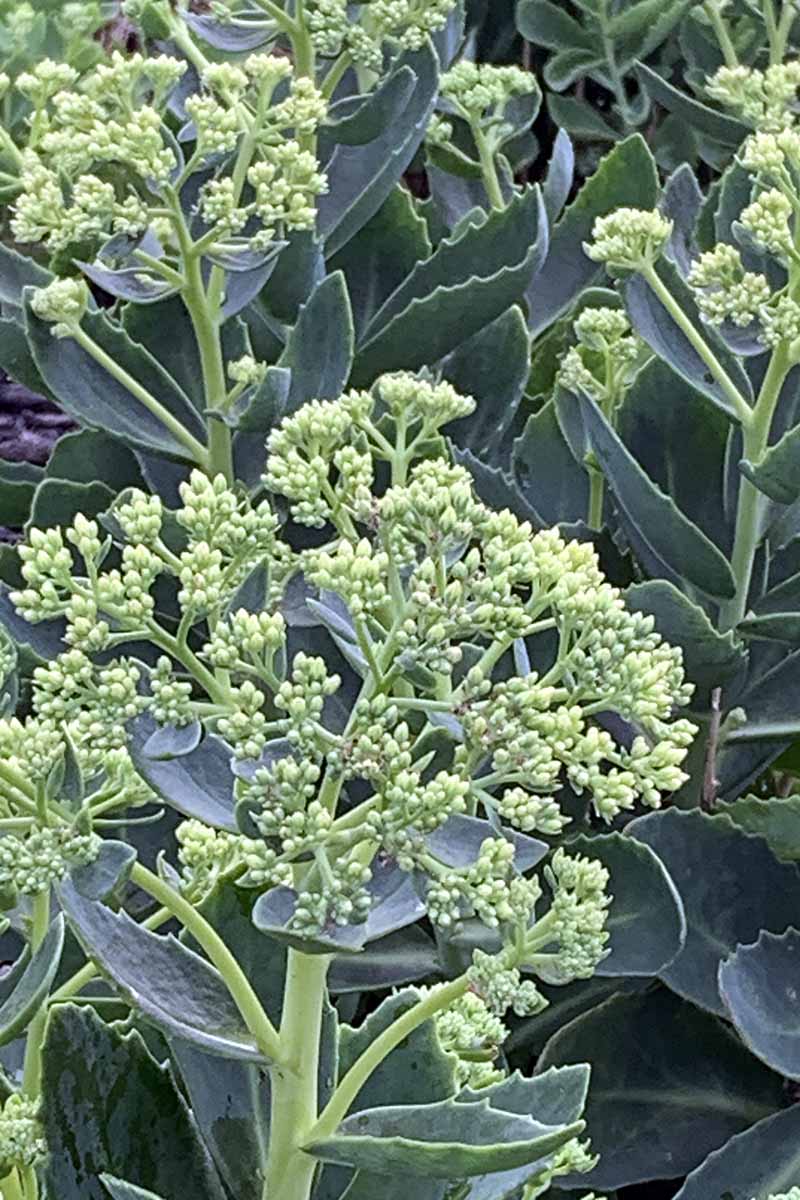
Upon blooming, the flat corymbs of star-shaped flowers offer exquisite visual appeal with their form and shape.
And pollinators like bees and butterflies find late-season forage and respite atop them.
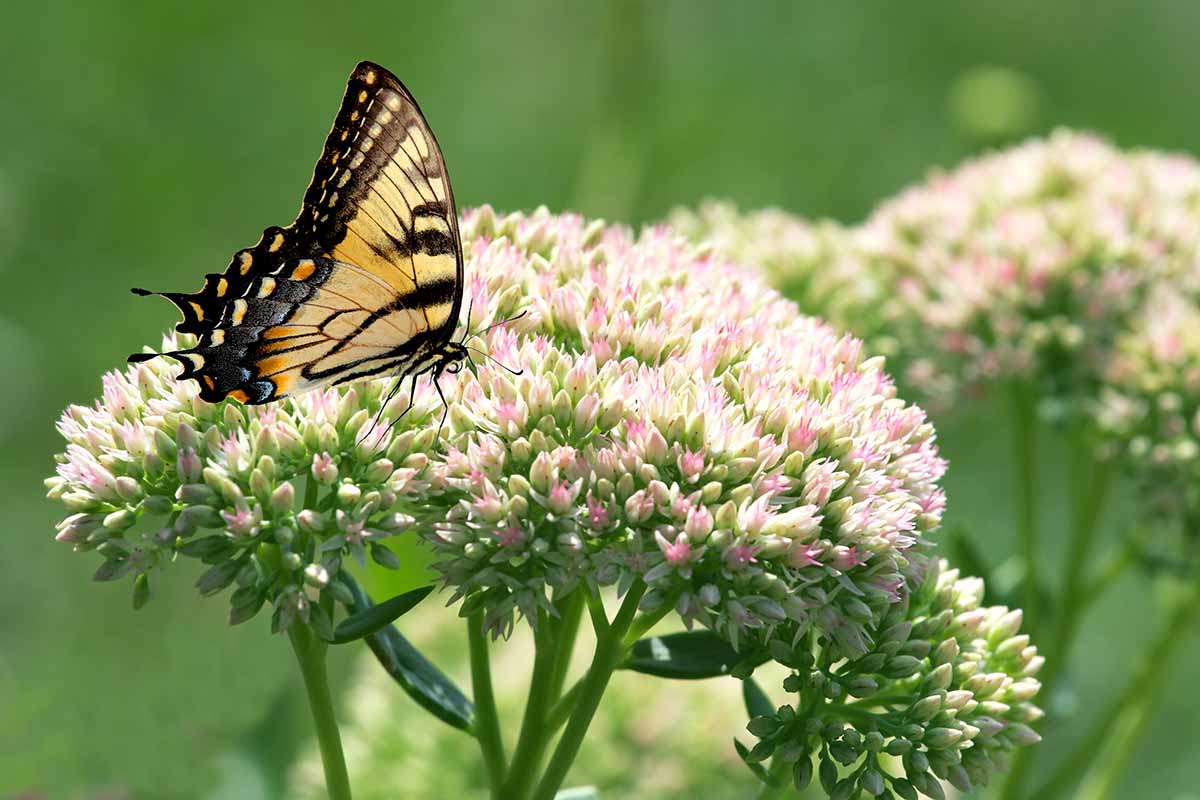
Over six to eight weeks, the color of the flowers deepens to a rich, deep red or pink hue, moving toward rusty bronze, and eventually to brown as the flower cycle comes to a close.
For those splendid weeks, ‘Autumn Joy’ gives gardens a much-needed punch of color, which is a welcome fall surprise!
No deadheading is necessary, and when left on its own, the plant can withstand cold and frost, extending interest and texture in the garden into winter.

Since this is a sterile cultivar, if flower stalks remain untouched through the winter, there’s no need to worry about unintentionally propagating new plants via spreading seeds.
Notorious for its low maintenance requirements, ‘Autumn Joy’ plants are fairly drought tolerant, and require little care. Like other types of sedum, dependable and quite respectful, rarely crowding out their neighbors.
This variety is a good candidate for mass planting, and it may be used in rock gardens, along borders and paths, and in containers. The blooms make delightful cut flowers that can also be dried for ornamental arrangements.
If you live in USDA Hardiness Zones 3 to 9, you’re sure to have success with ‘Autumn Joy.’
Cultivation and History
To understand the timeline of events, and how we have come to know the cultivar ‘Autumn Joy’ as we do today, we need to rewind and go back to the beginning of the sedum story.
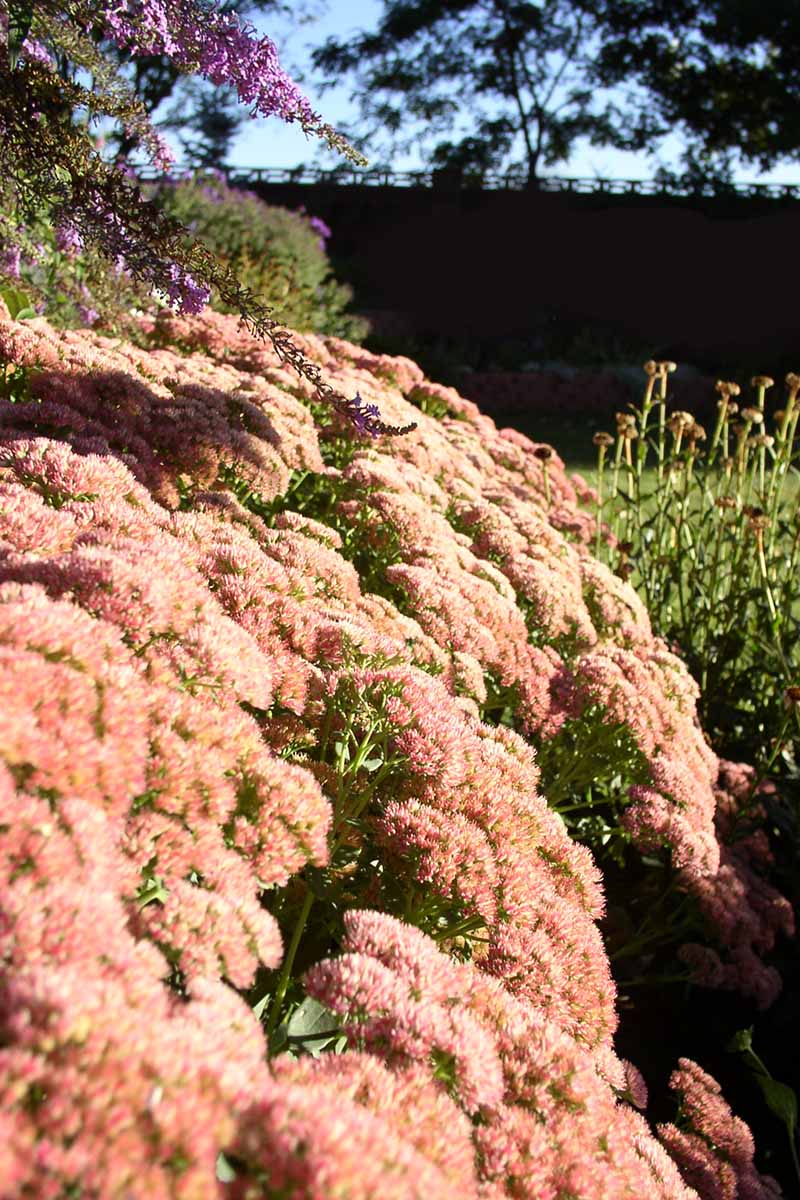
In 1753, Swedish botanist Carl Linnaeus assigned the scientific name Sedum in his renowned botanical publication called “Species Plantarum.”
Sedum is native to Europe and Asia, and the word “sedum” is derived from the Latin word “sedere,” which means “to sit,” – a sensible name for this genus with a growth habit of clinging to the ground or other rocky surfaces.
Hundreds of varieties, cultivars, and hybrids of sedum belong to the large family Crassulaceae, the stonecrops. And ‘Autumn Joy’ is a well known “poster child” cultivar.
Georg Arends, a German nurseryman, raised this cultivar and introduced it in 1955.
The plant had accumulated a few different common or regional names during its infancy, including ‘Indian Chief,’ but the German name ‘Herbstfreude,’ which translates to ‘Autumn Joy,’ seemed to stick.
The cultivar made its way to North America sometime in the late 1950s. There was some speculation, but it appears to be a hybrid cross between two sedums – S. telephium and S. spectabile (aka showy sedum).
Let’s skip ahead to 1977. Scientist H. Ohba and his team studying the Sedum genus proposed to reclassify several species.
In 2004 Ohba’s team conducted DNA analysis and confirmed Hylotelephium a separate and distinct genus, and the telephium and spectabile species, amongst others, were reclassified.
In spite of the name change, it is still known often referred to as Sedum ‘Autumn Joy.’
Autumn Joy Plant Propagation
As I mentioned, this cultivar is sterile. It doesn’t possess a stamen or an anther. So how can you propagate it?
‘Autumn Joy’ can be propagated from cuttings, and by dividing and transplanting. Let’s review these methods.
From Leaf and Stem Cuttings
‘Autumn Joy,’ like other succulents, can easily be propagated from cuttings in the spring or early summer.
Clip fleshy, non-flowering stems about four to six inches long. Trim each stem just below a node and remove the lower leaves. You can also use the leaves you have removed for propagation.
Fill a tray or container with equal parts potting soil and sand. Nestle the freshly exposed ends of the leaves or cut end of the stems into the soil so they stand up straight.
Keep the tray in indirect light and ensure the potting medium remains moist. If conditions in your home or greenhouse are dry, you might consider covering the tray with plastic to retain moisture.
In about two to four weeks, the cuttings should have produced enough roots to proceed with transplanting.
From Divisions
Once you have established plants, the fastest way to multiply your stock is by dividing and transplanting.
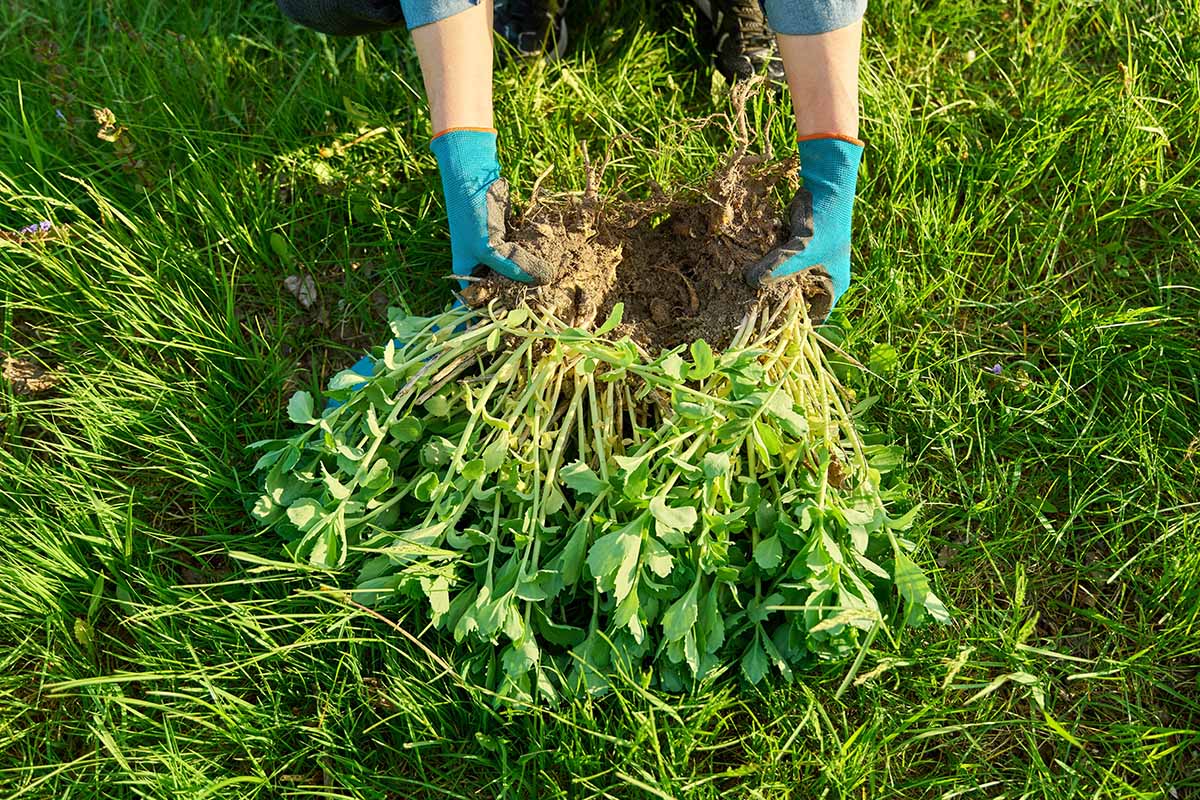
‘Autumn Joy’ should be divided every two to four years, presenting the perfect opportunity to increase your plot, add plants in other areas of your gardens, or share with friends.
Early spring is the best time to divide herbaceous perennials like sedum. As soon as you notice new growth poking out of the soil, carefully dig the whole plant up.
Divide the clump into sections with a sharp knife. Ensure each division contains a few shoots and a portion of the root system. Replant your divisions immediately or place them into pots to share with friends.
Transplanting
Transplanting ‘Autumn Joy’ is easy. When your rooted cutting is ready to plant – or if you have a potted start from a friend or a nursery – the steps are straightforward.
The best location in your garden for growing ‘Autumn Joy’ will have full sun and good drainage. Dig a hole about twice as wide and as deep as the root ball.
Gently set your plant in the hole and backfill with soil. Tamp slightly and give your transplant a drink of water.
How to Grow Autumn Joy Sedum
‘Autumn Joy’ is drought tolerant once established and does best in well-drained soil with average to low fertility.
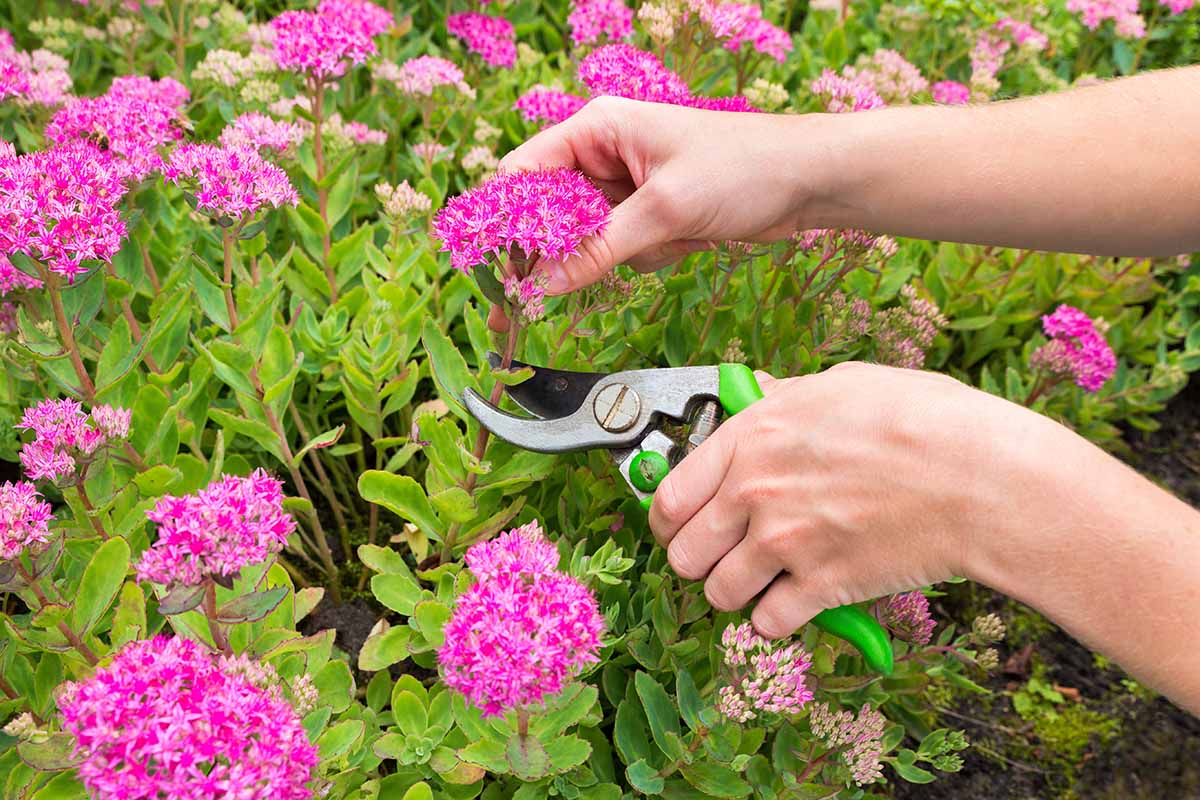
Suited for growing in Zones 3 to 9, this cultivar does best in full sun, though it can tolerate some light shade in the morning or afternoon.
Fertilizer can actually cause poor growth and flopping, so go easy on the additional nutrients.
As mentioned, this specimen is joyfully drought tolerant. Too much water can lead to root rot so it’s important to avoid overwatering.
Even during summer heat, one to two waterings per week – or when the top two inches of soil is dry – is more than enough, and if you’ve received recent rainfall, don’t water at all!
Growing Tips
- Plant in a full sun location.
- Make sure soil is well-draining.
- Water when the top two inches of soil is dry.
Maintenance
If I haven’t made it clear already, sedums are virtually maintenance-free. Save for a few minor tips to improve growth habits, this garden rebel prefers to be left alone.
When it comes to members of the Crassulaceae family, it’s more about what to avoid: overwatering and over-fertilizing.
Flower heads can become quite heavy and cause the tall, thin stems to flop over, so to encourage a full, upright shape and thick, sturdy stems, cut or pinch the plant back a few inches in spring to early summer before flowers begin to form.
This encourages the stems to become stronger so they’re able to hold more weight.
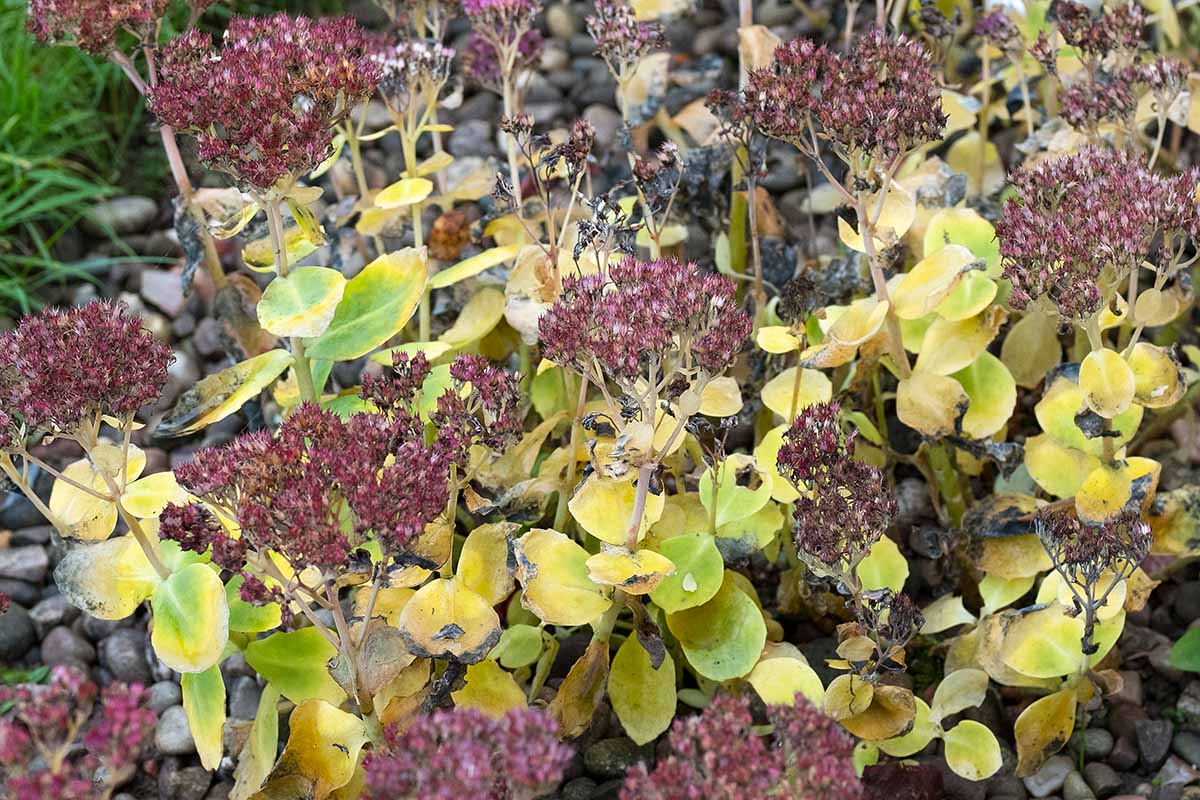
In preparation for winter, some folks like to deadhead ‘Autumn Joy,’ but it’s unnecessary.
Deadheading won’t damage the plant, so if you want to, go for it! I like to leave mine for a bit of late fall to early winter interest.
Feel free to apply some mulch around the base of the plant to tuck them in for winter, but if you don’t have time it’s not necessary.
If you do mulch, remember to gently clear some away in the spring to encourage new growth.
Where to Buy
You can usually find established potted transplants at your local garden center or nursery.
If you can’t get your hands on this plant locally or if you prefer the convenience of online shopping, check out Nature Hills Nursery to purchase a potted plant in a #1 container, which is about two to four quarts in volume.
Managing Pests and Disease
Animals like deer and rabbits are usually turned off by the bitter taste of these plants.
But if they’re hungry and desperate, they’ll feast on anything, including the unenjoyable foliage of ‘Autumn Joy.’
If you notice evidence of munching and you aren’t in the mood to share, consider setting up some barriers made of chicken wire to deter them.
‘Autumn Joy’ is generally hardy and resistant to most insect predators but it can be susceptible to a few. And because insects have the potential to introduce pathogens to plants, it’s wise to stay aware of what’s going on in your gardens.
Watch out for aphids, mealybugs, scale, slugs and snails, and black vine weevils. And keep in mind that wet soils can perpetuate root rot.
For more information about pests and disease pathogens that may attack sedums, including the best methods to treat them, check out our guide to growing sedum.
Best Uses of Autumn Joy Stonecrop
‘Autumn Joy’ is a perfect specimen for rock gardens, borders and paths, and mass plantings, especially in a well-planned design to highlight the fall blooms.
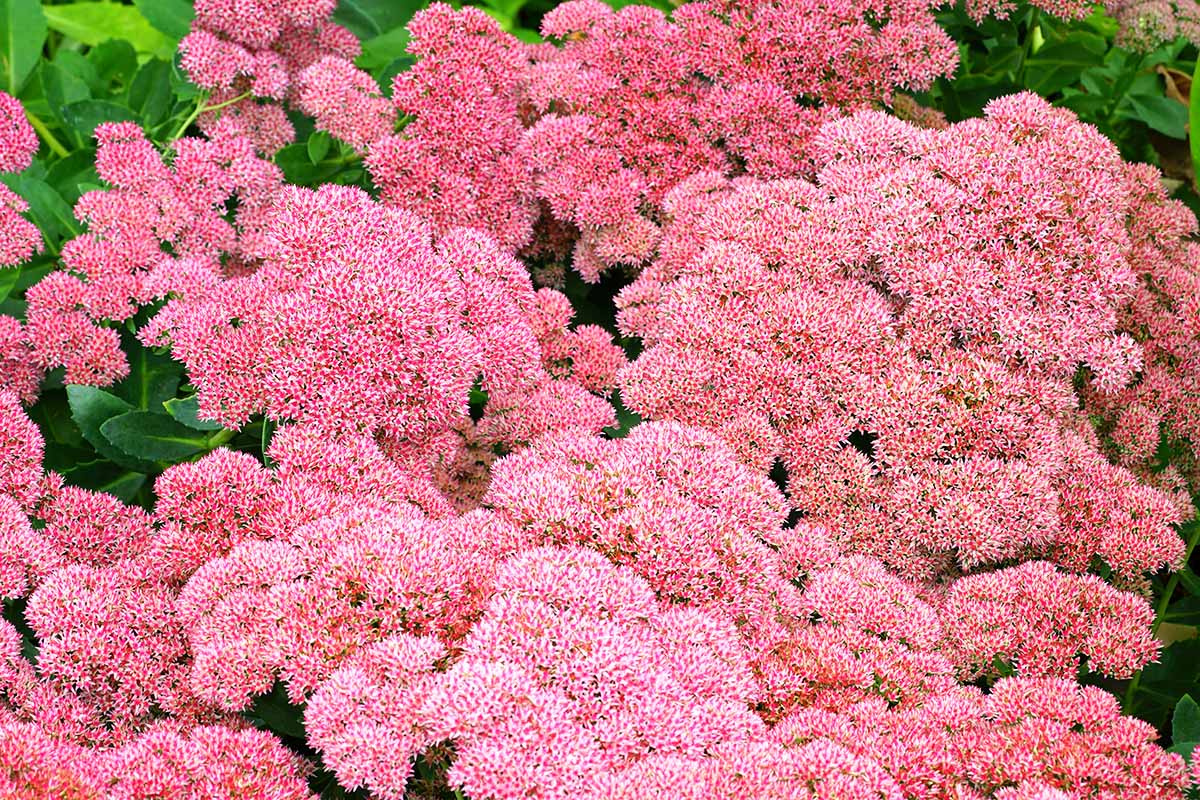
This cultivar also produces attractive cut flowers for arrangements and dried flowers for decorative accents.
Living roofs often incorporate sedums because of their resistance to drought. It’s no surprise that xeriscaping experts also put these hardy plants to work in their designs.
‘Autumn Joy’ and other stonecrops are also favorites of permaculture practitioners, revered for their value as herbaceous ground covers that attract pollinators to food-producing food forests.
Some people also incorporate the fleshy leaves of ‘Autumn Joy’ and other sedums into their diets.

The leaves are juicy with a mild, lemony flavor. From spring until fall, snack on them while you’re working out in the garden or toss them into a mixed greens salad.
Sedums are generally non-toxic and safe to consume, but if you’ve never ingested a particular plant you may not know of a potential sensitivity or allergy.
Misidentification of plants is easy. Take into consideration potential risks before using.
Quick Reference Growing Guide
| Plant Type: | Flowering, herbaceous succulent | Flower / Foliage Color: | Pink/green |
| Native to: | Cultivated variety | Tolerance: | Deer, drought, poor soil, rabbits |
| Hardiness (USDA Zone): | 3-9 | Soil Type: | Average |
| Bloom Time: | Fall | Soil pH: | 6.6-7.8 |
| Exposure: | Full sun | Soil Drainage: | Well-draining |
| Spacing: | 24 inches | Attracts: | Pollinators |
| Planting Depth: | Top of root ball even with soil line (transplants) | Uses: | Rock gardens, path and border edging, mass planting; cut and dried flowers |
| Height: | 15-24 inches | Order: | Saxifragales |
| Spread: | 15-24 inches | Family: | Crassulaceae |
| Water Needs: | Low | Genus: | Hylotelephium syn. Sedum |
| Maintenance | Low | Species: | Spectabile x telephium |
| Common Pests and Diseases: | Aphids, mealybugs, nematodes, scale, slugs, snails, weevils; root rot | Cultivar: | 'Autumn Joy' |
A Joy in All Seasons
‘Autumn Joy’ is a delight to the eyes, low maintenance, and tolerant to most any soil type and Hardiness Zone in the contiguous United States.
It’s a joy to have in the garden all year long; give it full sun and you’re in for a vibrant fall treat.

A favorite in my gardens, and I hope it will be in yours too! Are you growing ‘Autumn Joy’? Let us know in the comments section below!
To learn more about growing and caring for succulents, check out these guides next:
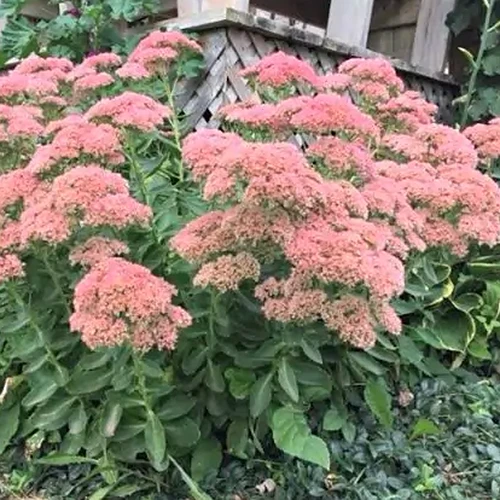

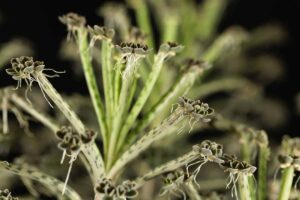
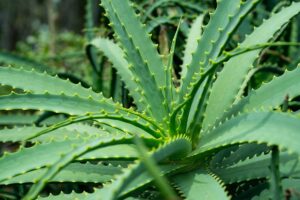
My Autumn Joy remains green all Fall; does not turn the rosy color I expected. My garden is adjacent to another where the foliage is a beautiful reddish/pink. It gets sun and is in a well drained rock garden. I am tempted to fertilize it with “Pro-Gro” but internet info. advises against fertilizing. Do you have any sugestions?
Hi Judy! If you’ve got your ‘Autumn Joy’ in full sun and well-draining soil, that’s great! But if it’s located in a different garden, separate from your successfully blooming plants, it might be another factor causing the delay. If this is its first year in this location, I’d give it some time to catch up to the others. Sometimes new transplants don’t perform at their best during the first year of planting. It could still bloom this fall – there’s still some time for it to show color. Or it could catch up next year. If this plant has been… Read more »
I received a potted Autumn Joy recently and I see that it is not recommended to transplant until early Spring. Can I keep the potted plant in the house over the winter – will it go dormant or continue to grow ?
Hi Debra. This is a great question – thanks for asking! The answer depends on where you’re located. If you’re in a warm climate, or you’ve still got at least six weeks before the ground freezes, it should be okay to plant now. For example, here in Zone 5b we’ve had a long, warm fall so far. But knowing the freeze is coming soon for me, I would wait. Your new transplant needs time to become rooted before the freeze. If winter is on its way, you can treat your plant to a few months indoors. It should go dormant,… Read more »